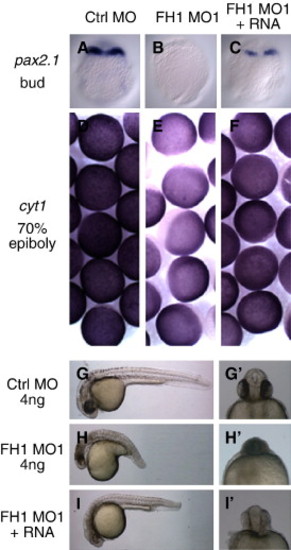Fig. 5
- ID
- ZDB-FIG-071019-37
- Publication
- Pei et al., 2007 - An early requirement for maternal FoxH1 during zebrafish gastrulation
- Other Figures
- All Figure Page
- Back to All Figure Page
|
Rescue of FoxH1 morphant phenotypes by co-injection of foxH1mRNA. (A–F) Rescue of selected molecular markers. Wild type embryos were injected with 8 ng of the indicated MO, or co-injected with 8 ng of the indicated MO together with 150 pg of foxh1 mRNA, then incubated and fixed at the indicated stages for whole-mount in situ analysis. Embryos in A–C are at bud stage, dorsal view. 100% (N = 29) of control embryos had strong staining, as in panel A, whereas 86% (N = 22) of FoxH1 morphants had no visible stain, as in panel B. When foxh1 mRNA was co-injected with FoxH1 MO1, 77% (N = 26) displayed moderate staining, as in panel C. Embryos in panels D–F are generally in an animal pole view orientation. A consistent increase in cyt1 expression is seen in embryos co-injected with foxh1 mRNA. (G–I) Rescue of dysmorphology caused by a low dose of FoxH1 MO1. Wild type embryos were injected with 4 ng of control MO, 4 ng of FoxH1 MO1, or 4 ng of FoxH1 MO1 + 150 pg foxh1mRNA, as indicated. 95% (N = 22) of control MO-injected embryos appeared WT, as in panel G and G2, whereas 68% (N = 41) of FoxH1 MO1-injected embryos displayed gross developmental perturbations. When foxh1 mRNA was co-injected with FoxH1 MO1, 89% (N = 47) displayed substantially milder phenotypes, and this milder phenotype was indistinguishable from the phenotype of WT embryos injected with foxH1 mRNA (data not shown, but see Fig. S1, C for comparison). Primes (2) indicate frontal views for the same embryos. Abbreviations: FH1, FoxH1; ctrl, control. |
| Genes: | |
|---|---|
| Fish: | |
| Knockdown Reagent: | |
| Anatomical Terms: | |
| Stage Range: | Shield to Bud |
Reprinted from Developmental Biology, 310(1), Pei, W., Noushmehr, H., Costa, J., Ouspenskaia, M.V., Elkahloun, A.G., and Feldman, B., An early requirement for maternal FoxH1 during zebrafish gastrulation, 10-22, Copyright (2007) with permission from Elsevier. Full text @ Dev. Biol.

